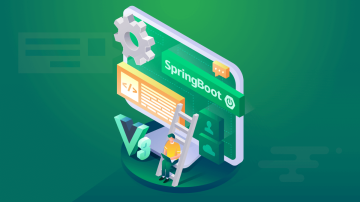本文详细介绍了SpringBoot企业级开发教程,涵盖了从SpringBoot简介到企业级应用实战的全过程。文章深入讲解了SpringBoot的核心特性、项目搭建、安全与权限控制等内容,帮助初学者快速掌握SpringBoot的开发技巧。以下为各章节的具体内容概要:
- SpringBoot简介:介绍SpringBoot的基本概念、最新版本特性以及其优势。
- SpringBoot项目搭建:指导读者如何设置开发环境,创建和导入SpringBoot项目,使用IDE进行开发。
- SpringBoot核心特性介绍:详细介绍自动配置、依赖注入、Starter依赖管理和Actuator监控等功能。
- 实战:构建第一个企业级应用:通过构建RESTful API、数据库操作和项目打包部署,展示如何使用Spring Boot开发企业级应用。
- 测试与调试:介绍单元测试、集成测试、异常处理及调试技巧。
- 安全与权限控制:讲解Spring Security的基础、用户认证与授权以及权限控制规则。
SpringBoot是什么
Spring Boot 是一个基于Spring框架的开源框架,旨在简化新Spring应用的初始搭建以及开发过程。它通过约定优于配置的方式,帮助开发者快速构建独立的、生产级别的基于Spring的应用程序。Spring Boot 2.6版本引入了新的特性,如增强的缓存支持和改进的日志框架。Spring Boot 可以以最少的配置实现自动配置、自动装配,使得Java开发者更加专注于业务逻辑的实现,而不需要花费大量时间在配置上。
SpringBoot的优势
- 自动配置:Spring Boot 通过自动配置机制,可以自动配置绝大多数Spring应用所需的bean,极大地简化了开发者的配置工作。
- 生产就绪:Spring Boot 附带了大量整合库的默认配置,使得开发者可以专注于业务逻辑,而无需关心底层的基础设施。
- 嵌入式Servlet容器:Spring Boot 可以嵌入Tomcat、Jetty或Undertow等Servlet容器,使应用能够直接运行,而无需部署到外部的容器。
- 无代码生成和XML配置:Spring Boot 提倡使用Java注解来代替XML配置,减少了代码的复杂性。
- 支持多种数据库:Spring Boot 提供了对多种数据库的支持,如MySQL、PostgreSQL等,开发者可以通过简单的配置快速连接到数据库。
- 自动装配:通过
@EnableAutoConfiguration注解,Spring Boot 可以实现自动化装配,大大简化了配置过程。 - 健康检查:Spring Boot Actuator 提供了详细的健康信息,帮助开发者了解应用的运行状态。
SpringBoot与传统Spring的区别
- 配置简化:Spring Boot 通过约定优于配置的方式,减少了XML配置,简化了配置过程。
- 自动化:Spring Boot 提供了大量的自动配置,可以自动配置Spring应用所需的bean。
- 生产就绪:Spring Boot 附带了大量生产级别的配置,使得开发者可以专注于业务逻辑,而无需关心底层的基础设施。
- 嵌入式容器:Spring Boot 可以嵌入Tomcat、Jetty或Undertow等Servlet容器,使应用能够直接运行,而无需部署到外部的容器。
- 无代码生成:Spring Boot 提倡使用Java注解来代替XML配置,减少了代码的复杂性。
- 支持多种数据库:Spring Boot 提供了对多种数据库的支持,开发者可以通过简单的配置快速连接到数据库。
安装Java开发环境
- 下载并安装Java:访问Oracle官网下载最新版本的Java JDK,安装完成后设置环境变量。
- 验证安装:打开命令行窗口,输入
java -version和javac -version,展示Java版本信息,确保安装成功。
创建SpringBoot项目
-
通过Spring Initializr创建项目:
- 访问Spring Initializr网站(https://start.spring.io/)。
- 在页面上选择项目类型、项目语言、Spring Boot版本、项目模块等。
- 点击“Generate Project”按钮,下载项目压缩包。
- 解压压缩包,导入到IDE中进行开发。
-
使用Maven或Gradle创建项目:
- 使用Maven:
<project xmlns="http://maven.apache.org/POM/4.0.0" xmlns:xsi="http://www.w3.org/2001/XMLSchema-instance" xsi:schemaLocation="http://maven.apache.org/POM/4.0.0 http://maven.apache.org/xsd/maven-4.0.0.xsd"> <modelVersion>4.0.0</modelVersion> <groupId>com.example</groupId> <artifactId>demo</artifactId> <version>0.0.1-SNAPSHOT</version> <name>demo</name> <description>Demo project for Spring Boot</description> <properties> <java.version>11</java.version> </properties> <dependencies> <dependency> <groupId>org.springframework.boot</groupId> <artifactId>spring-boot-starter-web</artifactId> </dependency> <dependency> <groupId>org.springframework.boot</groupId> <artifactId>spring-boot-starter-test</artifactId> <scope>test</scope> </dependency> </dependencies> <build> <plugins> <plugin> <groupId>org.springframework.boot</groupId> <artifactId>spring-boot-maven-plugin</artifactId> </plugin> </plugins> </build> </project> -
使用Gradle:
plugins { id 'org.springframework.boot' version '2.3.4.RELEASE' id 'io.spring.dependency-management' version '1.0.10.RELEASE' id 'java' } group = 'com.example' version = '0.0.1-SNAPSHOT' sourceCompatibility = '11' repositories { mavenCentral() } dependencies { implementation 'org.springframework.boot:spring-boot-starter-web' testImplementation 'org.springframework.boot:spring-boot-starter-test' }
- 使用Maven:
- 使用IDEA或其他IDE进行开发:
- 导入项目:将创建的Spring Boot项目导入到IDEA或其他IDE中。
- 运行项目:在IDEA中,可以直接点击项目启动类(默认为
Application类),运行Spring Boot应用。
自动配置
自动配置是Spring Boot的核心特性之一,它通过自动配置机制,可以自动配置绝大多数Spring应用所需的bean,极大地简化了开发者的配置工作。Spring Boot使用@EnableAutoConfiguration注解来实现自动配置。
@Configuration
@EnableAutoConfiguration
public class Application {
public static void main(String[] args) {
SpringApplication.run(Application.class, args);
}
}依赖注入
依赖注入是Spring框架的核心特性之一,Spring Boot继承了Spring的依赖注入特性。依赖注入使得开发者可以专注于业务逻辑的实现,而不需要关心对象之间的依赖关系。
@Service
public class UserService {
// 业务逻辑
}
@RestController
public class UserController {
private final UserService userService;
public UserController(UserService userService) {
this.userService = userService;
}
@GetMapping("/users")
public List<User> getAllUsers() {
return userService.getAllUsers();
}
}Starter依赖管理
Spring Boot通过Starter依赖来简化依赖的管理工作。例如,spring-boot-starter-web包含了构建一个Web应用程序所需的所有依赖,开发者只需添加一个依赖,即可获得完整的Web开发环境。
<dependency>
<groupId>org.springframework.boot</groupId>
<artifactId>spring-boot-starter-web</artifactId>
</dependency>Actuator监控
Spring Boot Actuator 提供了详细的健康信息和运行时指标,帮助开发者了解应用的运行状态。可以通过spring-boot-starter-actuator依赖来启用Actuator。
<dependency>
<groupId>org.springframework.boot</groupId>
<artifactId>spring-boot-starter-actuator</artifactId>
</dependency>启用Actuator后,可以通过访问/actuator路径来查看应用的状态信息。
创建RESTful API
使用Spring Boot构建RESTful API非常简单,只需定义一个控制器类即可。
@RestController
@RequestMapping("/api/users")
public class UserController {
@Autowired
private UserService userService;
@GetMapping("/")
public List<User> getAllUsers() {
return userService.getAllUsers();
}
@PostMapping("/")
public User createUser(@RequestBody User user) {
return userService.createUser(user);
}
}使用Spring Data JPA进行数据库操作
Spring Data JPA简化了数据库操作,提供了JPA的高级特性,开发者只需定义接口方法,即可实现数据库操作。
@Entity
public class User {
@Id
@GeneratedValue(strategy = GenerationType.IDENTITY)
private Long id;
private String name;
private String email;
// 省略getter和setter
}
@Repository
public interface UserRepository extends JpaRepository<User, Long> {}
@Service
public class UserService {
@Autowired
private UserRepository userRepository;
public List<User> getAllUsers() {
return userRepository.findAll();
}
public User createUser(User user) {
return userRepository.save(user);
}
}日志管理与配置
Spring Boot默认使用logback作为日志框架,可以通过application.properties或application.yml文件来配置日志级别。
# application.properties
logging.level.root=INFO
logging.level.com.example=DEBUG项目打包与部署
- 打包项目:使用Maven或Gradle命令打包项目。
- Maven:
mvn clean package - Gradle:
./gradlew clean build
- Maven:
- 部署项目:将生成的jar文件部署到Tomcat或Jetty等Servlet容器中,或者直接使用Spring Boot内置的Tomcat容器运行。
- 使用内置Tomcat容器运行:
java -jar target/demo.jar
- 使用内置Tomcat容器运行:
单元测试与集成测试
-
单元测试:使用Spring Boot的
@SpringBootTest注解进行单元测试。-
示例代码:
@SpringBootTest class UserServiceTest { @Autowired private UserService userService; @Test void testGetAllUsers() { List<User> users = userService.getAllUsers(); // 断言 assertEquals(2, users.size()); } }
-
-
集成测试:使用Spring Boot的
@SpringBootTest注解进行集成测试。-
示例代码:
@SpringBootTest(webEnvironment = WebEnvironment.RANDOM_PORT) class UserControllerTest { @Autowired private TestRestTemplate restTemplate; @Test void testGetAllUsers() { ResponseEntity<List<User>> response = restTemplate.getForEntity("/api/users", List.class); assertEquals(HttpStatus.OK, response.getStatusCode()); assertEquals(2, response.getBody().size()); } }
-
异常处理与日志记录
-
全局异常处理:定义全局异常处理器,处理未捕获的异常。
@ControllerAdvice public class GlobalExceptionHandler { @ExceptionHandler(value = {Exception.class}) public ResponseEntity<String> handleException(Exception e) { return new ResponseEntity<>("An error occurred: " + e.getMessage(), HttpStatus.INTERNAL_SERVER_ERROR); } } -
日志记录:在代码中添加日志记录,便于调试和问题追踪。
@Component public class UserComponent { private static final Logger log = LoggerFactory.getLogger(UserComponent.class); public void createUser(User user) { log.info("Creating user: {}", user.getName()); // 业务逻辑 } }
调试技巧
- 断点调试:在IDE中设置断点,运行程序时在断点处暂停,查看变量值和调用栈。
- 日志输出:通过日志输出关键信息,便于分析问题。
- Spring Boot Actuator:使用Actuator提供的健康检查、信息查看等功能,帮助调试应用。
Spring Security基础
Spring Security是Spring的官方安全模块,用于保护Web应用程序的安全。它支持多种认证和授权机制,如HTTP Basic认证、表单登录、OAuth等。
实现用户认证与授权
-
配置Spring Security:
-
添加依赖:
<dependency> <groupId>org.springframework.boot</groupId> <artifactId>spring-boot-starter-security</artifactId> </dependency> -
配置安全规则:
@SpringBootApplication public class SecurityApplication { public static void main(String[] args) { SpringApplication.run(SecurityApplication.class, args); } @Bean public SecurityFilterChain filterChain(HttpSecurity http) throws Exception { http .authorizeHttpRequests((authz) -> authz .requestMatchers("/api/public/**").permitAll() .anyRequest().authenticated() ) .httpBasic(Customizer.withDefaults()); return http.build(); } }
-
-
自定义用户认证:
-
配置自定义的用户认证器:
@Configuration public class SecurityConfig { @Bean public UserDetailsService userDetailsService() { return new UserDetailsService() { @Override public UserDetails loadUserByUsername(String username) throws UsernameNotFoundException { // 实现自定义的用户认证逻辑 return User.withDefaultPasswordEncoder() .username("admin") .password("password") .authorities("ADMIN") .build(); } }; } }
-
配置权限控制规则
-
基于角色的权限控制:
-
配置角色权限:
@SpringBootApplication public class SecurityApplication { public static void main(String[] args) { SpringApplication.run(SecurityApplication.class, args); } @Bean public SecurityFilterChain filterChain(HttpSecurity http) throws Exception { http .authorizeHttpRequests((authz) -> authz .requestMatchers("/api/public/**").permitAll() .requestMatchers(HttpMethod.POST, "/api/users").hasRole("ADMIN") .anyRequest().authenticated() ) .httpBasic(Customizer.withDefaults()); return http.build(); } }
-
-
自定义权限控制:
-
实现自定义的权限处理逻辑:
@Configuration public class SecurityConfig { @Bean public SecurityFilterChain filterChain(HttpSecurity http) throws Exception { http .authorizeHttpRequests((authz) -> authz .requestMatchers("/api/public/**").permitAll() .requestMatchers(HttpMethod.POST, "/api/users").access("@customAccessDecisionManager.hasPermission(#oauth2User)") .anyRequest().authenticated() ) .httpBasic(Customizer.withDefaults()); return http.build(); } @Bean public CustomAccessDecisionManager customAccessDecisionManager() { return new CustomAccessDecisionManager(); } } public class CustomAccessDecisionManager implements AccessDecisionManager { @Override public void decide(Authentication authentication, Object object, Collection<ConfigAttribute> configAttributes) { // 自定义权限处理逻辑 if (object instanceof OAuth2User) { OAuth2User oauth2User = (OAuth2User) object; if (oauth2User.getAttribute("role").equals("ADMIN")) { return; } } throw new AccessDeniedException("Access denied"); } }
-
通过以上配置,可以实现对不同用户角色的权限控制,确保只有具有相应权限的用户才能访问特定的资源。

 随时随地看视频
随时随地看视频




